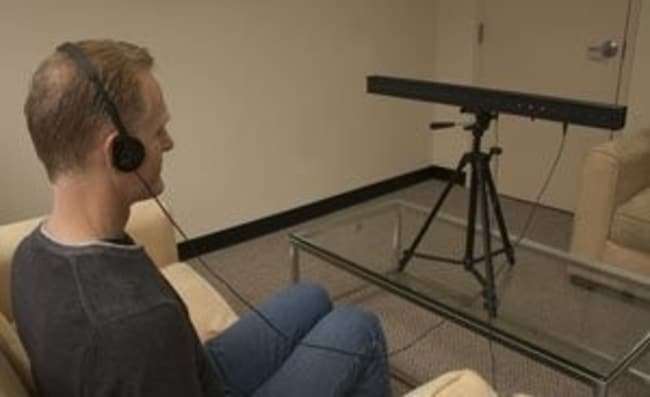How EMDR has been conducted has quickly expanded due to the coronavirus and rapid growth of telehealth. There are now many offerings for “at-home EMDR treatments”; however, clients need to proceed with caution and be fully aware of the risks before engaging in these home-based programs.
Can EMDR be done virtually?
Virtual EMDR is possible thanks to many advancements in modern technology. Read my other post on how to do EMDR virtually to learn more about the process.
Can you do EMDR by yourself?
EMDR is an effective and safe treatment for PTSD, anxiety and many other mental health diagnoses. It is possible to self-administer EMDR on yourself; however, it is not often recommended.
If you do decide to try a self-administered EMDR program, it is recommended to only do so for smaller-scale traumas, such as something “minor” that has happened in the present. I use the term “minor” loosely, since it is the client’s perception of an event and their nervous system that dictates how major or minor it feels.
What are the risks of self-administered EMDR?
There are many risks involved if you do EMDR at home by yourself, including:
-
retraumatization
-
worsening symptoms of dissociation
-
intense abreactions (intense emotional experiences associated with reliving a traumatic event)
-
ineffective results
Working with a skilled EMDR therapist will help to minimize all of these risks. If you have a history of complex trauma, childhood trauma or a “Big T” trauma, such as sexual assault, combat or war experiences, a near death experience, etc., is is NOT recommended to administer EMDR by yourself at home.
An EMDR therapist will make sure to get a full history as part of the therapy (phase 1) and make sure you have adequate calming skills (phase 2) to minimize the risks listed above.
It’s also important to note that the therapeutic relationship is significantly important in the efficacy of any therapy, including EMDR Therapy. So, working with a therapist whom you have a solid therapeutic rapport with is a huge factor for successful outcomes in therapy.
Remember, EMDR is more than just eye movements. It’s an 8 phase process, which it what makes it such a comprehensive and effective therapy. If you do decide to use a self-administered EMDR, it can be helpful to consult with a skilled EMDR professional first to make sure there is minimal risk involved.
About the Author

Dana Carretta-Stein is a Licensed Mental Health Counselor and founder of Peaceful Living Mental Health Counseling, PLLC, and Carretta Consulting in Scarsdale, NY. She specializes in clinical psychotherapy to treat children, adolescents and adults with anxiety, behavior and trauma difficulties.
She is a certified EMDR therapist, consultant in training, and Regional Coordinator of the Westchester EMDR Regional Network. Dana is also a business coach for wellness practitioners who are looking to build and grow their private practice.
#EMDRTherapy #VirtualEMDR #EMDR #Telehealth #mentalhealth #Counseling #MentalHealthCounseling #TraumaTherapy #Anxiety #PTSD #Wellness #Scarsdale #Eastchester #Westchester #WestchesterTherapists
Do It Yourself EMDR: Is It Possible? Is It Safe?
You may have heard of EMDR, which stands for Eye Movement Desensitization and Reprocessing. The technique is used by therapists for processing difficult or traumatic experiences. This is done in an office environment with someone who is trained in the technique. However, it is possible for clients to learn a do it yourself EMDR program that they can use at home?
How Does EMDR Work?
According to the EMDR Institute, EMDR is an eight-phase program. In Phases 3-6, a therapist has the client use bilateral stimulation while processing images that come to mind. This stimulation can come in the form of eye movements or even hand buzzers that vibrate. The imagery contains thoughts or memories that the client finds distressing. The idea is to get the client to a point where they no longer find the memories disturbing and can substitute positive beliefs for the negative. Eventually, the client is able to resolve the traumatic memories and no longer feels distressed.
Learning Do It Yourself EMDR
Part of the EMDR process is to actually learn techniques for easing anxiety that you can do outside of sessions. These are methods you can learn from your therapist, or may be found online. For instance:
- “Hug” Method: Bring up the palm of each hand and cross them over the chest onto the forearm of the opposing arm. Close your eyes and be aware of your breathing. Gently tap the left, then right hands. When your mind drifts, bring it back to the tapping.
- While sitting, lay each of your hands palm-down onto your legs. Close your eyes, focusing on your breathing. Then begin to tap your legs with your hands. This creates that bilateral stimulation.
These are techniques you can do anytime when you begin to feel anxious. Your therapistwill have other ideas as well.
Is EMDR Safe?
EMDR is a safe technique for processing trauma. There may be times when very difficult memories come to the surface. These can be processed to better understand them. You can always stop until you feel better. The EMDR Institute notes that there isn’t any evidence that EMDR will cause seizures. Only three people have had seizures using EMDR, and they already had seizures prior to treatment.
Are There Other Do It Yourself EMDR Resources?
Yes! Again, the EMDR Institute has a book available on its website called “Getting Past Your Past: How to Take Control of Your Life with Self-Help Techniques from EMDR Therapy.” The book provides examples of EMDR methods and exercises to help you practice them. Want another resource? Look no further than YouTube! A simple search of the site brings up lots of videos that teach EMDR.
Is Do It Yourself EMDR Possible?
The short answer: partially. It is possible to learn how to cope with the anxiety and distress that comes up from experiencing a traumatic memory. Being able to handle these moments effectively can help in your recovery process. However, obtaining the full benefits of EMDR requires being able to talk with a therapist to process the memories and resolve them. His or her support can be helpful for stretching yourself to face memories that you may be more tempted to avoid. The result is a more in-depth process than what you would get alone.
EMDR is a safe and effective technique for those who struggle with traumatic memories and want help. Clients can incorporate EMDR into their everyday lives for periods when these images come up. A therapist though, can help you get the full benefit of this technique by guiding you through the process. Also, it helps that therapists can be a sounding board, aid your navigation through tough memories, and help you resolve the past.
Questions, Concerns, Thoughts?
I invite you to call me for a free 15 – minute phone consultation to discuss your specific needs and to answer any questions you have about anxiety, treatment and my practice. Please visit my website @ www.theanxietydocseattle.com or call me directly @ (206) 745-4933.
Read more about Anxiety Treatment.
As a BetterHelp affiliate we may receive compensation if you sign up for online counseling through the links provided.
EMDR (Eye-Movement Desensitization and Reprocessing) is a therapeutic modality designed to decrease and potentially eliminate negative emotional memories associated with traumatic experiences. Unlike traditional psychotherapy, it involves having the patient recall a traumatic memory while moving their eyes back and forth. Eye movements are a form of what is referred to as “bilateral stimulation”. It is traditionally performed with a trained EMDR therapist who evaluates the patient, guides the process, and helps the patient replace unhelpful thinking patterns with more functional ones. The theory is that the eye movements allow the brain to heal from the trauma by changing how the memories are stored. It may come as a surprise that EMDR can be self-administered in your own home. However, it is important to emphasize that going to a professional is often usually best. Finding an EMDR practitioner through BetterHelp.com (EMDRHealing.com readers get 15% off) is an excellent, cost-efficient option. If you are interested in this route, fill out this questionnaire carefully to be matched with a suitable EMDR therapist.
The Pros And Cons Of Self-Administered EMDR
A small 2013 study by Spence, Titov, and Johnson et.al evaluated the effects of self-administered EMDR. They found significant improvements in subjects who self-administered after three months in spite of inconsistencies in methodology. Though none of the participants reported serious adverse effects, some patients did have an increase in traumatic re-experiencing following treatment. A few reported an overall worsening of symptoms but this improved by the time of follow-up. Nine out of the 11 participants who completed post-treatment questionnaires said they would recommend the course to a friend.
Experienced EMDR practitioner Dr. James Alexander had this to say about self-administered EMDR:
“Yes, it can be self-administered (as can EFT)- but, not advisable when dealing with anything other than very small t traumas (and the distinction between them and Big T traumas can disappear quickly once you get into them- we are often surprised by how much charge even small traumas can entail). Overall, I’d suggest that we are not really ‘meant’ to try and address trauma on our own. So, I’d recommend getting over any reserve and working with a skilled therapist. And keep in mind, there is no necessity for big cathartic responses to EMDR- some people will demonstrate this, others won’t, and there is no difference in the outcomes.
People have differing levels of comfort with emotional expression- EMDR is not trying to force any particular mode, just allowing people to respond in a way they feel comfortable with.
Good EMDR happens in the context of a good therapeutic relationship- in which there is mutual trust built up over a period of time. That will generally allow people to freedom to respond in a manner which is natural to them.”
Even if you choose to attempt self-administered EMDR, it is recommended that you meet with a certified EMDR therapist first. It is also important to understand that administering EMDR without fully understanding the process can be inefficient and result in partial, minimal, or no trauma resolution. In some cases those who practice EMDR alone retraumatize themselves by stirring up old traumas that they are not equipped to handle. With these words of caution in mind, self-administered EMDR can be of great benefit to those who thoroughly understand the technique and trust themselves to handle whatever may surface during the process. Furthermore, many would argue that it is better to try to treat yourself than continue to suffer.
Scenarios in which self-administered EMDR may be appropriate include:
- Lack of access to an EMDR therapist
- Inability to afford formal treatment
- Old traumas are triggered by life events and you are unable to access mental health services quickly
- Any life event that causes acute symptoms such high anxiety or a “fight or flight” response from which you are seeking immediate relief
Whether or not you choose to practice self-administered EMDR is a personal choice. It is ultimately up to your judgement and intuition if self-administered EMDR is right for you.
Understanding EMDR In Its Entirety
If you choose to self-administer EMDR, it is wise to study the complete technique first and familiarize yourself with all of the phases of treatment. EMDR has evolved into a structured 8 stage process with distinct phases that go well beyond the eye movements alone.
The following is an outline of the eight step EMDR process when conducted by a trained practitioner:
- Client History- target memories are identified
- Preparation- client is prepared for the process
- Assessment- client’s memories, feelings, beliefs, etc. are fully assessed
- Desensitization- memories are processed using eye movements or other forms of bilateral stimulation
- Installation- negative beliefs associated with memories are replaced with positive ones
- Body Scan- client undergoes another round of bilateral stimulation to eliminate any lingering physiological symptoms
- Closure- ensure client is returned to a state of balance at the end of session
- Re-evaluation- check that distressing memory has been fully processed
See also our detailed article on the EMDR process for a full breakdown of each step in more detail.
While using EMDR it is vital to understand that bilateral stimulation is only part of the process. It is very important to include the installation stage if you are performing self-administered EMDR. This means identifying self-defeating and dysfuntional beliefs such as, “I’m worthless”, or “I can’t do anything”, and consciously replacing them with more adaptive thoughts like, “I can take charge of my life,” and “I’m not powerless anymore”. This is performed after traumas have been processed with bilateral stimulation. Practicing self-awareness and paying attention to your thought process will increase insight into habitual thought patterns.
Below are a few videos from EMDR founder Francine Shapiro and EMDR therapist James Alexander that provide in depth explanations of how the technique works:
EMDR Webinar Francine Shapiro
EMDR Explained Part 1
EMDR Explained Part 2
DIY EMDR
There are many online resources on sites such as YouTube that facilitate self-administered EMDR. Numerous videos utilize bilateral stimulation that mimics the movements EMDR therapists typically make with their fingers while instructing patients to focus on a specific distressing memory. The videos frequently guide viewers to follow dots that move across the screen to produce the same effect. The use of a moving, external stimulus distracts the mind and allows the traumatic memory to “blur” and lessen in intensity.
Here is a video that includes the installation phase in addition to the actual trauma processing. This particular video works on replacing distressing memories and a sense of helplessness with healthy, positive, and self-empowering beliefs.
https://www.youtube.com/watch?v=FkuqlRkMk_sVideo can’t be loaded because JavaScript is disabled: Nature’s EMDR (https://www.youtube.com/watch?v=FkuqlRkMk_s)
Here are some more self adminstered EMDR videos on Youtube, which all follow the same kind of principle of providing something for you to follow on screen whilst focusing on an internal state. Click on each one to pop up the video.
The Importance Of Dual Focus
Another key principle to keep in mind while practicing self-administered EMDR is the need to maintain a dual focus of attention. This means simultaneously directing your attention towards both the bilateral stimulation and an internal state of discomfort. There must be a combined focus on both the external bilateral stimulation and an internal state of physiological activation for EMDR to be successful. Focusing on one without the other will not be therapeutic. Just paying attention to bilateral stimulation without holding a disturbing memory in mind will not impact the trauma. More importantly, simply concentrating on a distressing memory or state without attempting to remedy the situation can retraumatize the individual, making the situation worse. Instead, it is crucial to maintain a dual state of focus in order to effectively process and remove the trauma. The dual state of focus distracts the mind which allows the brain to let go of the trauma. The negatively charged emotion attached to the memory diminishes and is neutralized. The once powerful memory becomes an event that happened in the past. It is also important to point out that simply watching an EMDR video will not be helpful unless the person activates a disturbing memory on the physiological level during the treatment. The individual must be experiencing anxiety or a fight/flight response in the current moment while working with bilateral stimulation.
Combining Auditory and Visual Bilateral Stimulation
Though not a formal part of the EMDR process, some practitioners have found that combining auditory and visual bilateral stimulation has a synergistic effect and is much more powerful than using one type of input on its own. Auditory bilateral stimulation can be achieved by listening to a bilateral stimulation recording with headphones where a noise is alternated between the left and right ears. Therapists who believe in this method have observed that adding this to the formula has a marked advantage over only using visual inputs and can quickly and effectively eliminate undesirable states. Why this method may be more effective is uncertain. Perhaps the additional stimulation adds to the potency of the method and allows the traumas to dissolve more quickly. There are many videos available that offer music containing auditory bilateral stimulation, however, they can be less reliable than visual bilateral stimulation videos. EMDR practitioner Dr. James Alexander offers legitimate audio bilateral stimulation recordings on his website tailored to this therapeutic modality. The recording (“Bilateral Stimulation and Nature Sounds”) can be found here for $10 at https://www.drjamesalexander-psychologist.com/apps/webstore/
For best results, listen with headphones that fit over the ears instead of ear buds.
Can You Use EMDR Devices at Home?
It’s safe to say that for self-administered EMDR, the use of an EMDR device may be necessary. Without devices, you’ll need manual bilateral stimulation, which only a therapist can provide.
However, as you’re administering the therapy by yourself, you need a device to go through the processing phase and use bilateral stimulation on yourself.
For instance, you can use a light bar in front of you to guide your eye movements. You can set the light color, brightness, and speed. Press start and continue your session. You may even change the settings during the session any time you want to, so the control is basically in your hands.
Similarly, you can use other devices for the very same purpose, allowing you to safely and effectively complete this important part of the EMDR therapy.
It’s easy and safe to use these devices at home. However, there will be a little bit of a learning curve as you’ll need to first figure out how the device works exactly and how you can use it during your session.
While there are virtual tools as well for bilateral stimulation, having a physical one may be more beneficial. You can control it better with a controlling device right in your hand as you sit on the couch and focus on your inner thoughts, emotions, and feelings. You don’t have to sit up to use a computer screen again and again as the tool is physically present in front of you.
Keep in mind the use also depends on the virtual tool you’re using for EMDR. The best way to ensure your self-administered therapy goes well is to use a comprehensive virtual EMDR tool like ours that also provides a complete tool set to complete EMDR therapy in the comfort of your zone.
With the devices integrated with the virtual therapy tool, you don’t have to do much. Otherwise, there’s a lot of work before therapy, which can be confusing and frustrating for the person already dealing with so much.
More importantly, our toolset comes at 10 percent of the cost of buying a device separately. Basically, everything is included at the same price. So you don’t have to pay for the tool and the devices separately.
Types of EMDR Devices
When doing EMDR with a virtual tool, you may need to resort to EMDR devices. However, the device you use depends on the type of bilateral stimulation you’re pursuing.
There are three kinds of bilateral stimulation used in EMDR: visual, auditory, and tactile.
- Visual bilateral stimulation refers to the eye movements from side to side or up and down following a moving object like a finger or light.
- Auditory bilateral stimulation involves alternating sounds in ears, i.e., sound plays in one ear, then in the other, and so on.
- Tactile bilateral stimulation involves tapping shoulders or knees alternately, from left to right and right to left.
There are devices for all three types of bilateral stimulations.
Light Bars
Light bars are horizontal bars on a vertical stand, fixed with LED lights. The light moves from side to side to guide eye movement. It may be controlled with a controller device or wirelessly through an application or software.
The light settings can be changed. For example, the speed with which the light moves can be changed.
(See also: Should You Invest in a Light Bar?)
Headphones
Headphones are for audio stimulation, often with accompanying software that plays the sound in alternating ears and controls how slow or fast it plays in each ear.
Tappers
Tappers, also called buzzers or paddles, are for tactile stimulation. These are small handheld devices, one held in each hand that vibrates in an alternating pattern to mimic tapping. Like other EMDR devices, their settings can also be adjusted.
(See also: EMDR Tappers & Where to Buy Them)
Self Administered EMDR Programs
There are also online self-administered EMDR programs available for purchase that offer a structured program. A popular option is Virtual EMDR which can tried out for free here. This program guides the user step-by-step through self-administered EMDR. The company offers a free trial as well as making it available to veterans and first responders at no cost.
Conclusion
Self-administering EMDR is still a controversial issue. Research and opinions from experts have identified both positive and negative aspects of attempting to perform this technique on your own. However, there are clear cases where people have benefitted from self-administered EMDR. There are numerous resources and supports available if you wish to learn this method.



